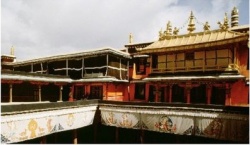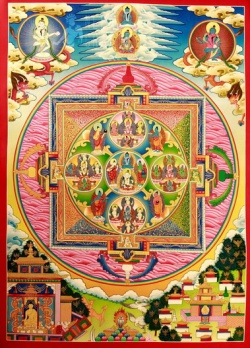Difference between revisions of "Zhitro"
| Line 1: | Line 1: | ||
[[File:Zhitro_new.jpg|thumb|250px|]] | [[File:Zhitro_new.jpg|thumb|250px|]] | ||
| − | In [[Tibetan Buddhism]] and [[Bön]], | + | In [[Tibetan Buddhism]] and [[Bön]], [[Zhitro]] ([[Tibetan]]; Wylie: [[zhi khro]], alternate phonetic transcription: [[shitro]], [[xitro]]) or [[Karling Zhitro]] ([[kar gling zhi khro]], after [[Karma Lingpa]], the [[treasure-revealer]] who (re)discovered it) is the [[name]] of a genre of [[scripture]] and associated [[tantric]] practices primarily concerned with the "Hundred [[Peaceful]] and [[Wrathful Deities]]". The best-known (though by no means only) example of this genre is "[[The Great Liberation by Hearing in the Intermediate State]]," better known in the [[west]] as "The [[Tibetan Book of the Dead]]". |
[[File:14.Bardo-mandala.jpg|thumb|250px|]] | [[File:14.Bardo-mandala.jpg|thumb|250px|]] | ||
=={{Wiki|Exegesis}}== | =={{Wiki|Exegesis}}== | ||
| Line 7: | Line 7: | ||
The [[Dzogchen]] practice of [[Zhitro]] involves viewing the [[body]] as a [[mandala]] of both [[peaceful]] and [[wrathful deities]], the inclusivity promoting [[awareness]] in the practitioner of the universality of [[Buddha-nature]]. As a [[subtle body]] practice using [[yogic]] practices to {{Wiki|manipulate}} the {{Wiki|lung}}, or subtle-winds, of the [[body]], this is a [[completion stage]] practice of the [[Inner Tantras]]. The [[Lion's Roar]] [[Tantric]] Glossary describes the [[Zhitro]] [[mandala]] practice: | The [[Dzogchen]] practice of [[Zhitro]] involves viewing the [[body]] as a [[mandala]] of both [[peaceful]] and [[wrathful deities]], the inclusivity promoting [[awareness]] in the practitioner of the universality of [[Buddha-nature]]. As a [[subtle body]] practice using [[yogic]] practices to {{Wiki|manipulate}} the {{Wiki|lung}}, or subtle-winds, of the [[body]], this is a [[completion stage]] practice of the [[Inner Tantras]]. The [[Lion's Roar]] [[Tantric]] Glossary describes the [[Zhitro]] [[mandala]] practice: | ||
| − | ::Zhi-khro is a practice of [[Tibetan Buddhism]] involving [[visualizing]] the [[body]] as a composite of the [[108]] [[peaceful]] and [[wrathful deities]]. In the practice, the [[deities]] are first visualized in [[mandalas]] of 58 [[peaceful]] and 42 [[wrathful deities]] centered in the [[heart]], {{Wiki|throat}} and [[crown chakra]], and then in all the channels and [[nadis]] of the [[body]]. | + | ::[[Zhi-khro]] is a practice of [[Tibetan Buddhism]] involving [[visualizing]] the [[body]] as a composite of the [[108]] [[peaceful]] and [[wrathful deities]]. In the practice, the [[deities]] are first visualized in [[mandalas]] of 58 [[peaceful]] and 42 [[wrathful deities]] centered in the [[heart]], {{Wiki|throat}} and [[crown chakra]], and then in all the [[channels]] and [[nadis]] of the [[body]]. |
| − | Shugchang, et al. (2000) define and frame the Zhi-khro teachings in [[relation]] to the [[Inner Tantras]], [[Anuyoga]], [[Atiyoga]], [[Guhyagarbha tantra]], [[rigpa]], [[Śūnyatā]], [[non-duality]], kye-rim, dzog-rim and [[bardo]]: | + | [[Shugchang]], et al. (2000) define and frame the [[Zhi-khro]] teachings in [[relation]] to the [[Inner Tantras]], [[Anuyoga]], [[Atiyoga]], [[Guhyagarbha tantra]], [[rigpa]], [[Śūnyatā]], [[non-duality]], [[kye-rim]], [[dzog-rim]] and [[bardo]]: |
| − | ::The zhi-khro, which translates as the [[peaceful]] and [[wrathful deities]], is considered part of the [[inner tantra]]. It is actually a condensed [[teaching]] based upon the [[essential]] meaning of the [[Guhyagarbha Tantra]] combined with the [[views]] expressed in the anu and [[ati yoga]] teachings. Many great [[masters]] have said that the zhi-khro teachings are the [[inner tantra]] of the [[inner tantra]]. In this case we're not making distinctions among the various [[inner tantras]], nor between the creation and completion stages, but joining them all together. This is the union of [[rigpa]] and [[emptiness]], the [[oneness]] of [[birth]], [[death]], and [[life]] [[experiences]]. There is no basis for discriminating because all are aspects of one [[true nature]]. | + | ::The [[zhi-khro]], which translates as the [[peaceful]] and [[wrathful deities]], is considered part of the [[inner tantra]]. It is actually a condensed [[teaching]] based upon the [[essential]] meaning of the [[Guhyagarbha Tantra]] combined with the [[views]] expressed in the anu and [[ati yoga]] teachings. Many great [[masters]] have said that the [[zhi-khro]] teachings are the [[inner tantra]] of the [[inner tantra]]. In this case we're not making distinctions among the various [[inner tantras]], nor between the creation and completion stages, but joining them all together. This is the union of [[rigpa]] and [[emptiness]], the [[oneness]] of [[birth]], [[death]], and [[life]] [[experiences]]. There is no basis for discriminating because all are aspects of one [[true nature]]. Nothing is rejected or exclusively accepted. This [[teaching]] is known as the one that unifies everything into a single state. |
| − | Gyatso (2006) relates how [[Zhitro]] was received by [[Yeshe Tsogyal]] through the wang of a [[Vidyadhara]] through the [[Bardo]] of [[trance]]: | + | Gyatso (2006) relates how [[Zhitro]] was received by [[Yeshe Tsogyal]] through the [[wang]] of a [[Vidyadhara]] through the [[Bardo]] of [[trance]]: |
| − | ::After succeeding in a variety of feats, including beheading a {{Wiki|tiger}}, she gains access to an elaborate palace where she receives [[esoteric]] [[initiations]] from several vidyādharas and [[buddhas]]. She returns to Chingpu and after a year is robbed by seven bandits whom she then converts to [[Buddhist practice]]. She proceeds with the bandits on a [[magic]] carpet to the place [[Oḍḍiyāna]] where they all receive [[peaceful]] and [[wrathful deity]] practice ([[zhitro]]) [[initiations]] from a [[vidyādhara]], who gives her the secret [[name]] Kharchen Za and cavorts in [[bliss]] with her. | + | ::After succeeding in a variety of feats, including beheading a {{Wiki|tiger}}, she gains access to an elaborate palace where she receives [[esoteric]] [[initiations]] from several [[vidyādharas]] and [[buddhas]]. She returns to Chingpu and after a year is robbed by seven bandits whom she then converts to [[Buddhist practice]]. She proceeds with the bandits on a [[magic]] carpet to the place [[Oḍḍiyāna]] where they all receive [[peaceful]] and [[wrathful deity]] practice ([[zhitro]]) [[initiations]] from a [[vidyādhara]], who gives her the secret [[name]] [[Kharchen Za]] and cavorts in [[bliss]] with her. |
{{W}} | {{W}} | ||
[[Category:Bardo]] | [[Category:Bardo]] | ||
[[Category:Nyingma Texts]] | [[Category:Nyingma Texts]] | ||
Revision as of 16:50, 9 October 2013
In Tibetan Buddhism and Bön, Zhitro (Tibetan; Wylie: zhi khro, alternate phonetic transcription: shitro, xitro) or Karling Zhitro (kar gling zhi khro, after Karma Lingpa, the treasure-revealer who (re)discovered it) is the name of a genre of scripture and associated tantric practices primarily concerned with the "Hundred Peaceful and Wrathful Deities". The best-known (though by no means only) example of this genre is "The Great Liberation by Hearing in the Intermediate State," better known in the west as "The Tibetan Book of the Dead".
Exegesis
A prominent sadhana, or practice text, is part of a group of bardo teachings which are held in the Nyingma tradition to have originated with Padmasambhava in the 8th century and were rediscovered as terma, or 'treasure teachings' in the 14th Century by the tertön Karma Lingpa. The Zhitro mandala teachings were found in the same terma collection as the Bardo Thodol, a text well known in the West as The Tibetan Book of the Dead.
The Dzogchen practice of Zhitro involves viewing the body as a mandala of both peaceful and wrathful deities, the inclusivity promoting awareness in the practitioner of the universality of Buddha-nature. As a subtle body practice using yogic practices to manipulate the lung, or subtle-winds, of the body, this is a completion stage practice of the Inner Tantras. The Lion's Roar Tantric Glossary describes the Zhitro mandala practice:
- Zhi-khro is a practice of Tibetan Buddhism involving visualizing the body as a composite of the 108 peaceful and wrathful deities. In the practice, the deities are first visualized in mandalas of 58 peaceful and 42 wrathful deities centered in the heart, throat and crown chakra, and then in all the channels and nadis of the body.
Shugchang, et al. (2000) define and frame the Zhi-khro teachings in relation to the Inner Tantras, Anuyoga, Atiyoga, Guhyagarbha tantra, rigpa, Śūnyatā, non-duality, kye-rim, dzog-rim and bardo:
- The zhi-khro, which translates as the peaceful and wrathful deities, is considered part of the inner tantra. It is actually a condensed teaching based upon the essential meaning of the Guhyagarbha Tantra combined with the views expressed in the anu and ati yoga teachings. Many great masters have said that the zhi-khro teachings are the inner tantra of the inner tantra. In this case we're not making distinctions among the various inner tantras, nor between the creation and completion stages, but joining them all together. This is the union of rigpa and emptiness, the oneness of birth, death, and life experiences. There is no basis for discriminating because all are aspects of one true nature. Nothing is rejected or exclusively accepted. This teaching is known as the one that unifies everything into a single state.
Gyatso (2006) relates how Zhitro was received by Yeshe Tsogyal through the wang of a Vidyadhara through the Bardo of trance:
- After succeeding in a variety of feats, including beheading a tiger, she gains access to an elaborate palace where she receives esoteric initiations from several vidyādharas and buddhas. She returns to Chingpu and after a year is robbed by seven bandits whom she then converts to Buddhist practice. She proceeds with the bandits on a magic carpet to the place Oḍḍiyāna where they all receive peaceful and wrathful deity practice (zhitro) initiations from a vidyādhara, who gives her the secret name Kharchen Za and cavorts in bliss with her.

